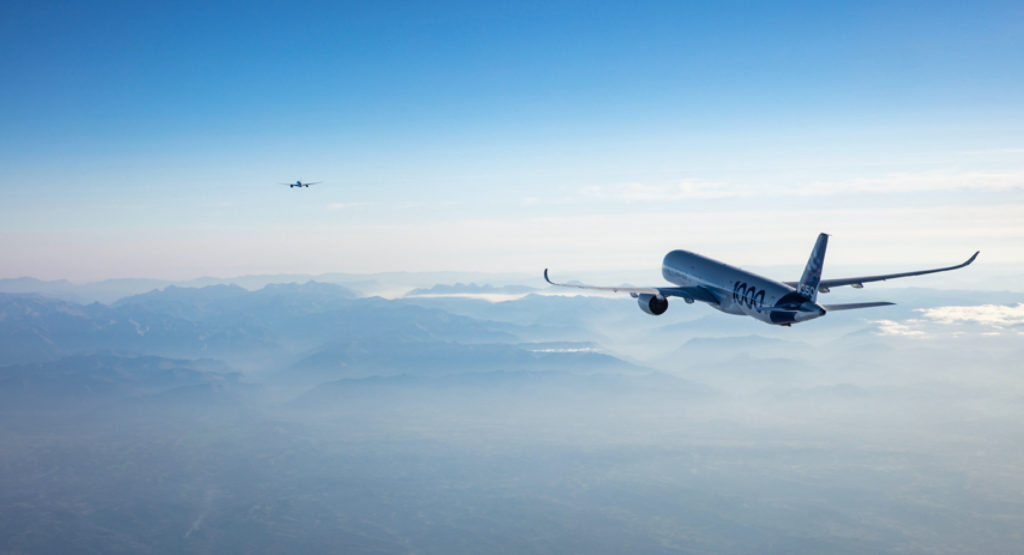Estimated reading time 7 minutes, 16 seconds.
On Nov. 9, Airbus successfully performed the first “long-haul demonstration of formation flight in general air traffic (GAT) regulated transatlantic airspace,” as part of the company’s fello’fly demonstrator project. The flight from Toulouse, France, to Montreal, Quebec, involved two A350s that flew just three kilometers apart.
The “follower” A350-1000 (MSN59) was able to fly safely in the wake updraft of the “leader” A350-900 (MSN1), which gave the follower aircraft the ability to reduce engine thrust and fuel consumption. Fello’fly project leader Nick MacDonald said an estimated six tonnes of CO2 was saved on the flight, “confirming the potential for more than a five percent fuel savings on long-haul flights.”

The fello’fly project was launched in 2019, after Airbus began to study the close-V migratory formations of geese. The formations are led by one bird, while the trailing geese “surf” the invisible upwash of smooth air generated by the flapping birds ahead.
To translate this concept to jet airliners, Airbus developed flight systems that automatically identify the vortex and move the follower aircraft slowly towards it laterally, “until we get to what we call the ‘sweet spot’ to the optimal position where the comfort in the cabin is nominal,” and also the fuel savings are within the aforementioned range, explained MacDonald during an Airbus presentation in Mirabel on Nov. 9.
The technology essentially involves data transmission from the leader aircraft. “So the leader aircraft is sending flight parameters to the follower aircraft, which then is fed into some pretty novel algorithms that we built in order to determine the nominal position of the vortex,” MacDonald continued. “And then as we come closer to the vortex, we’ll then identify that with the particular aerodynamic signature that we expect to see.”
Ultimately, the data being sent between the two A350s allow the aircraft to position laterally and keep a safe separation. The auto flight systems are not necessarily tracking the position of the aircraft, but rather the position of the vortex.
“This is where it differs a little bit from what some people typically think of formation flight,” MacDonald added. “We’ve got three kilometers apart from the aircraft. . . . So, it’s a little bit different from some of those formation flight technologies that are out there.”
Airbus has been doing flight testing for the past 18 months in French airspace with the two A350s that completed the recent transatlantic flight. Before flight tests took place, the technology was tested on numerous simulation platforms ranging in size.
The pioneering Nov. 9 flight with two A350s took off at 9 a.m. Toulouse time and joined up in French airspace. “We then brought the aircraft into tracking mode,” explained MacDonald. “So at this point, the pilots are ultimately trusting the aircraft to perform as expected. And we then transitioned into the Shanwick airspace, which is managed by the U.K., followed over into Gander, which, of course, is managed by Nav Canada, and then followed through into arrival into Montreal.”

The rendezvous in French airspace was 1,000 feet vertically separated, and the follower aircraft was 1.5 nautical miles (three kilometers) behind.
“So the beauty of this rendezvous is that it fits perfectly into the current rules in place; we’re not reinventing any rules up to this point,” said MacDonald.
The air traffic control (ATC) procedure that Airbus deployed involved the leader aircraft communicating with ATC, and the two A350 aircraft communicating between each other. Then, Airbus’s new flight system is deployed, which is ultimately a command from the pilots to do the “join up.” The follower aircraft then climbs to the same flight level as the leader aircraft, where the flight system will automatically identify the vortex.
On board the aircraft for the transatlantic flight were pilots from Airbus partner airlines, SAS Scandinavian Airlines and Frenchbee.
While the flight was roughly seven-and-a-half hours, MacDonald said Airbus’s technology can be applied on longer flights.
Sabine Klauke, chief technical officer at Airbus, said: “This demonstration flight is a concrete example of our commitment to making our decarbonization roadmap a reality. It also speaks to how collaboration across the industry will be key to making this happen. We have received a strong level of support for this project from our airline and air traffic partners, plus regulators. The opportunity to get this deployed for passenger aircraft around the middle of this decade is very promising.”
The next step for Airbus is to get support from authorities “so this new operational concept can be certified, and ultimately enable airlines to reduce their fuel burn and CO2 emissions,” the company said.









Congratulations Nick for a job well done. You are definitely in the shrine.Mother & Father